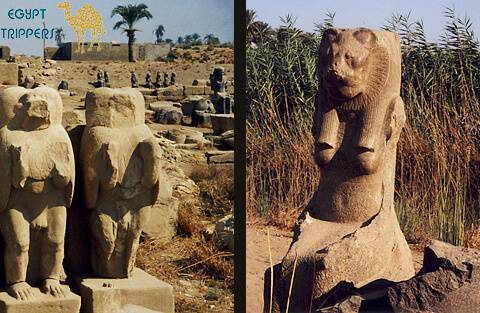During your Luxor tour, don’t miss visiting the majestic, ruined Temple of Mut, built in dedication to the daughter of the god of the sun Sekhmet, and others like Hathor, Bastet, and Nekhbet. Many ancient Egyptians revered Mut for her influence over the Nile floods and her ability to cure disease, as well as cause it if one fell into her disfavor. Mut was portrayed as an elegant woman with a Double Crown on her head, which signified her responsibility to protect the king and his office.
About The Temple of Mut in Luxor
The Temple of Mut in Luxor city is surrounded by crescent-shaped lake, sacred to ancient Egyptians and known as the Isheru. This lake held significance with the Eye of Re goddesses. Recent expeditions have discovered that the Temple dates back as far as the 25th Dynasty, when only the main Temple and the lake were present. In following centuries, more temples were built around the original.
By the time Ramesses II came to reign over Egypt, the collection of temples came to receive official names. The southern most temple was known as the Temple of Millions of Years in ancient Egyptian.
Though much of the Temple of Mut’s structures have fallen to erosion and the wear and tear of time, you can still see the porches constructed in its front. Earlier expeditions recorded a 24-column colonnade for the structure of the temple, alluding to its impressive size when it was still standing.

Some portions of the temple were even rebuilt over the ages, the south ends of each porch seeing new construction by the Ptolemies. Two large reliefs of Bes were added on each side. A small chapel at the south end of the western porch can also be seen, built into the base of the pylon. One of these chapels is actually a “hut-ka” for Montuemhat’s son Nesptah, which roughly translates into “soul house.”
On the north end, expeditions uncovered remains of a pink granite ram’s head, the figure of a king carved below its chin in the Kushite style. A companion ram was found several years later at the western porch. Although this ram’s head is missing, the base was still preserved. The Ptolemies had left both of these rams in place when renovating the porches during their rule.
These are just a few of the amazing and interesting features left standing in the Temple of Mut, with many more to entice and awe visitors. This is the perfect spot to visit if you’re a history buff, as the site is rife with rich Egyptian lore and ancient history. And for those of you who are less interested in the history of the place, it still holds a sense of mystery that only a site as ancient as this can bring to those who visit its crumbling walls.




Comment (0)